Mazar-i-Sharif
Mazār-i-Sharīf (Dari and Pashto: مزار شریف; [mæˈzɒːre ʃæˈriːf]), also called Mazār-e Sharīf, or just Mazar, is the fourth-largest city of Afghanistan, with a 2015 UN–Habitat population estimate 427,600.[1] It is the capital of Balkh province and is linked by highways with Kunduz in the east, Kabul in the southeast, Herat in the southwest and Termez in Uzbekistan in the north. It is about 55 km (34 mi) from the Uzbek border. The city also serves as one of the many tourist attractions because of its famous shrines as well as the Islamic and Hellenistic archeological sites. The ancient city of Balkh is also nearby.
Mazar-i-Sharif | |
|---|---|
City | |
 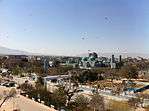  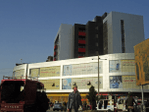 From top left to right: Afghan Air Force helicopter flies over Mazar-i-Sharif; View towards the Blue Mosque during Nowruz; Downtown; The Blue Mosque. | |
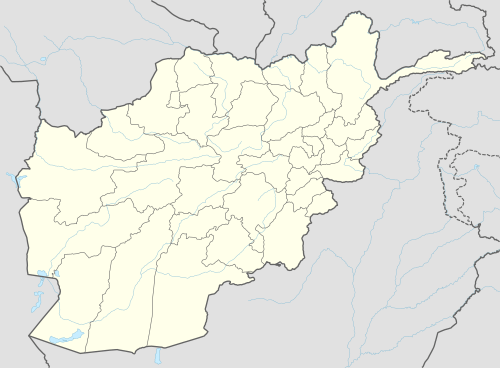 Location in Afghanistan | |
| Coordinates: 36°42′N 67°07′E | |
| Country | |
| Province | Balkh Province |
| District | Mazar-i-Sharif District |
| Government | |
| • Mayor | Abdullhaq Khurami |
| Area | |
| • Land | 83 km2 (32 sq mi) |
| Elevation | 357 m (1,171 ft) |
| Population (2015)[1] | |
| • Total | 427,600[1] |
| Time zone | UTC+4:30 (Afghanistan Standard Time) |
| Climate | BSk |
The name Mazar-i-Sharif means "Tomb of the Prince", a reference to the large, blue-tiled sanctuary and mosque in the center of the city known as the Shrine of Ali or the Blue Mosque. Some people believe that the tomb of Ali ibn Abi Talib, the cousin and son-in-law of the Islamic prophet Muhammad, is at this mosque in Mazar-i-Sharif, after Ali's remains were transferred to Mazar-i-Sharif as per request of Ja'far as-Sadiq. This is however rejected by other Muslims, as the majority believe he is buried in Najaf, Iraq.
The region around Mazar-i-Sharif has been historically part of Greater Khorasan and was controlled by the Tahirids followed by the Saffarids, Samanids, Ghaznavids, Ghurids, Ilkhanates, Timurids, and Khanate of Bukhara until the mid-18th century when it became part of the Durrani Empire after a friendship treaty was signed between emirs Murad Beg and Ahmad Shah Durrani. Mazar-i-Sharif is also known for the famous Afghan song Bia ke berem ba Mazar (Come let's go to Mazar) by Sarban.[2]
Mazar-i-Sharif is the regional hub of northern Afghanistan, located in close proximity to both Uzbekistan and Tajikistan. It is also home to an international airport. It has the highest percentage of built-up land (91%)[3] of all the Afghan provincial capitals, and it has additional built-up area extending beyond the municipal boundary but forming a part of the larger urban area. It is also the lowest-lying major city in the country, about 357 metres (1,171 ft) above sea level. The city was spared of the devastation that occurred in the country's other large cities during the Soviet–Afghan War and subsequent civil war, and is today regarded one of the safest cities in the country.[4]
History
Ancient period
The Achaemenids controlled the region from the sixth century BCE. Alexander the Great conquered the area but was then incorporated to the Seleucid Empire after his death. The decline of the Seleucids consequently led to the emergence of the Greco-Bactrian kingdom. Around 130 BCE, the Sakas occupied the region and the Greco-Bactrian kingdom fell. The Yuezhi took Mazar-i-Sharif and the surrounding area which led to the creation of the Kushan Empire. The Sasanians subsequently controlled the area after the fall of the Kushans. The Islamic conquests reached Mazar-i-Sharif in 651 CE.[5]
9th century until 1919
The region around Mazar-i-Sharif has been historically part of Greater Khorasan and was controlled by the Tahirids followed by the Saffarids, Samanids, Ghaznavids, Ghurids, Ilkhanates, Timurids, and Khanate of Bukhara. According to tradition, the city of Mazar-i-Sharif owes its existence to a dream. At the beginning of the 12th century, a local mullah had a dream in which the 7th century Ali bin Abi Talib, cousin and son-in-law of Muhammad, appeared to reveal that he had been secretly buried near the city of Balkh.
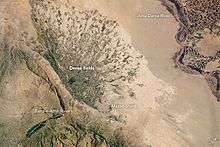
The famous Jalal al-Din Rumi was born in this area but like many historical figures his exact location of birth cannot be confirmed. His father Baha' Walad was descended from the first caliph Abu Bakr and was influenced by the ideas of Ahmad Ghazali, brother of the famous philosopher. Baha' Walad's sermons were published and still exist as Divine Sciences (Ma'arif). Rumi completed six books of mystical poetry and tales called Masnavi before he died in 1273.
After conducting researches in the 12th century, the Seljuk sultan Ahmed Sanjar ordered a city and shrine to be built on the location, where it stood until its destruction by Genghis Khan and his Mongol army in the 13th century. Although later rebuilt, Mazar stood in the shadow of its neighbor Balkh. During the nineteenth century, due to the absence of drainage systems and the weak economy of the region, the excess water of this area flooded many acres of the land in the vicinity of residential areas causing a malaria epidemic in the region. Thus the ruler of North Central Afghanistan decided to shift the capital of the city of Mazar-i-Sharif.[6]
The Mazar-i-Sharif means "the noble shrine". This name represents the Blue Mosque which is widely known to be the grave of Ali (Muhammad's son-in-law).[7]
The city along with the region south of the Amu Darya became part of the Durrani Empire in around 1750 after a treaty of friendship was reached between Mohammad Murad Beg and Ahmad Shah Durrani, the founding father of Afghanistan. In the late 1870s, Emir Sher Ali Khan ruled the area from his Tashkurgan Palace in Mazar-i Sharif. This northern part of Afghanistan was un-visited by the British-led Indian forces during the Anglo-Afghan wars of the 19th century.
Late 20th century
During the 1980s Soviet–Afghan War, Mazar-i-Sharif was a strategic base for the Soviet Army as they used its airport to launch air strikes on mujahideen rebels. Mazar-i-Sharif was also the main city that linked to Soviet territory in the north, especially the roads leading to the Uzbek Soviet Socialist Republic. As a garrison for the Soviet-backed Afghan Army, the city was under the command of General Abdul Rashid Dostum. Mujahideen militias Hezbe Wahdat and Jamiat-e Islami both attempted to contest the city but were repelled by the Army.
Dostum mutinied against Mohammad Najibullah's government on March 19, 1992, shortly before its collapse, and formed his new party and militia, Junbish-e Milli. The party took over the city the next day. Afterwards Mazar-i-Sharif became the de facto capital of a relatively stable and secular proto-state in northern Afghanistan under the rule of Dostum. The city remained peaceful and prosperous, whilst rest of the nation disintegrated and was slowly taken over by fundamentalist Taliban forces.[8] The city was called at the time a "glittering jewel in Afghanistan's battered crown". Money rolled in from foreign donors Russia, Turkey, newly independent Uzbekistan and others, with whom Dostum had established close relations.[9] He printed his own currency for the region and established his own airline.
This peace was shattered in May 1997 when he was betrayed by one of his generals, warlord Abdul Malik Pahlawan who allied himself with the Taliban, forcing him to flee from Mazar-i-Sharif as the Taliban were getting ready to take the city through Pahlawan. Afterwards Pahlawan himself mutinied the Taliban on the deal and it was reported that between May and July 1997 that Pahlawan executed thousands of Taliban members, that he personally did many of the killings by slaughtering the prisoners as a revenge for the 1995 death of Abdul Ali Mazari. "He is widely believed to have been responsible for the brutal massacre of up to 3,000 Taliban prisoners after inviting them into Mazar-i-Sharif."[10] Several of the Taliban escaped the slaughtering and reported what had happened. Meanwhile, Dostum came back and took the city again from Pahlawan.
However the Taliban retaliated in 1998 attacking the city and killing an estimated 8,000 noncombatants (see Battles of Mazar-i-Sharif (1997–98)). At 10 am on 8 August 1998, the Taliban entered the city and for the next two days drove their pickup trucks "up and down the narrow streets of Mazar-i-Sharif shooting to the left and right and killing everything that moved—shop owners, cart pullers, women and children shoppers and even goats and donkeys."[11] More than 8000 noncombatants were reported killed in Mazar-i-Sharif and later in Bamiyan.[12] In addition, the Taliban were criticized for forbidding anyone from burying the corpses for the first six days (contrary to the injunctions of Islam, which demands immediate burial) while the remains rotted in the summer heat and were eaten by dogs.[13] The Taliban also reportedly sought out and massacred members of the Hazara, while in control of Mazar.[11]
Since 2001
Following the September 11 attacks in 2001, Mazar-i-Sharif was the first Afghan city to fall to the U.S.-backed Northern Alliance (United Front). The Taliban's defeat in Mazar quickly turned into a rout from the rest of the north and west of Afghanistan. After the Battle of Mazar-i-Sharif in November 2001, the city was officially captured by forces of the Northern Alliance. They were joined by the United States Special Operations Forces and supported by U.S. Air Force aircraft. As many as 3,000 Taliban fighters who surrendered were reportedly massacred by the Northern Alliance after the battle, and reports also place U.S. ground troops at the scene of the massacre.[14] The Irish documentary Afghan Massacre: The Convoy of Death investigated these allegations. Filmmaker Doran claims that mass graves of thousands of victims were found by United Nations investigators.[15] The Bush administration reportedly blocked investigations into the incident.[16]
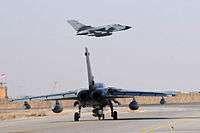
The city slowly came under the control of the Karzai administration after 2002, which is led by President Hamid Karzai. The 209th Corps (Shaheen) of the Afghan National Army is based at Mazar-i-Sharif, which provides military assistance to northern Afghanistan. The Afghan Border Police headquarters for the Northern Zone is also located in the city. Despite the security put in place, there are reports of Taliban activities and assassinations of tribal elders. Officials in Mazar-i-Sharif reported that between 20 and 30 Afghan tribal elders have been assassinated in Balkh Province in the last several years. There is no conclusive evidence as to who is behind it but majority of the victims are said to have been associated with the Hezb-i Islami political party.[17]
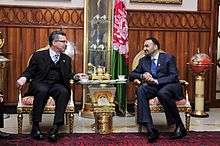


Small-scale clashes between militias belonging to different commanders persisted throughout 2002, and were the focus of intensive UN peace-brokering and small arms disarmament programme. After some pressure, an office of the Afghan Independent Human Rights Commission opened an office in Mazar in April 2003. There were reports about northern Pashtun civilians being ethnically cleansed by the other groups, mainly by ethnic Tajiks, Hazaras and Uzbeks.[18]
NATO-led peacekeeping forces in and around the city provide assistance to the Afghan government. ISAF Regional Command North, led by Germany, is stationed at Camp Marmal which lies next to Mazar-i-Sharif Airport. Since 2006, Provincial Reconstruction Team Mazar-i-Sharif had unit commanders from Sweden on loan to ISAF. The unit is stationed at Camp Northern Lights which is located 10 kilometres (6.2 miles) west of Camp Marmal. Camp Nidaros, located within Camp Marmal, has soldiers from Latvia and Norway and is led by an ISAF-officer from Norway.
In 2006, the discovery of new Hellenistic remains was announced.[19]
On April 1, 2011, as many as ten foreign employees working for United Nations Assistance Mission in Afghanistan (UNAMA) were killed by angry demonstrators in the city (see 2011 Mazar-i-Sharif attack). The demonstration was organized in retaliation to pastors Terry Jones and Wayne Sapp's March 21 Qur'an-burning in Florida, United States.[20] Among the dead were five Nepalese, a Norwegian, Romanian and Swedish nationals, two of them were said to be decapitated.[21][22][23] Terry Jones, the American pastor who was going to burn Islam's Holy Book, denied his responsibility for incitement.[24] President Barack Obama strongly condemned both the Quran burning, calling it an act of "extreme intolerance and bigotry", and the "outrageous" attacks by protesters, referring to them as "an affront to human decency and dignity." "No religion tolerates the slaughter and beheading of innocent people, and there is no justification for such a dishonorable and deplorable act."[25] U.S. legislators, including Senate Majority Leader Harry Reid, also condemned both the burning and the violence in reaction to it.[26]
By July 2011 violence grew to a record high in the insurgency.[27] In late July 2011, NATO troops also handed control of Mazar-i-Sharif to local forces amid rising security fears just days after it was hit by a deadly bombing. Mazar-i-Sharif is the sixth of seven areas to transition to Afghan control, but critics say the timing is political and there is skepticism over Afghan abilities to combat the Taliban insurgency.
On 10 November 2016, a suicide attacker rammed a truck bomb into the wall of the German consulate in Mazar-i-Sharif. At least four people were killed and more than one hundred others were injured.[28][29]
On 21 April 2017, a coordinated Taliban attack killed more than 100 people at Camp Shaheen, the Afghan Army base in Mazar-i-Sharif.[30]
In November 2018, it was revealed to the outside world that 40 houses in Qazil Abad, an immediate suburb of Mazar-i-Sharif, used unexploded Soviet Grad surface-to-surface rockets as construction materials. As a result, several people were killed and wounded from a few explosions over the years. These rockets, left behind by the Soviet Army in 1989 at the end of the Soviet–Afghan War, were used as cheap building materials by the poor residents of the village. It was estimated that over 400 rockets were incorporated into the village as wall and ceiling beams, door-stoppers, and even a footbridges used by children. When the outside world discovered this fact, the Danish demining group of the Danish Refugee Council visited the village and, after asking the residents, began demining and repairing the buildings, safely removing and disposing of the rockets through controlled detonation at the border with Uzbekistan.[31][32][33]
Geography
Climate
Mazar-i-Sharif has a cold steppe climate (Köppen climate classification BSk) with hot summers and cold winters. Precipitation is low and mostly falls between December and April. The climate in Mazar-i-Sharif is very hot during the summer with daily temperatures of over 40 °C (104 °F) from June to August. The winters are cold with temperatures falling below freezing; it may snow from November through March.[34]
| Climate data for Mazar-i-Sharif | |||||||||||||
|---|---|---|---|---|---|---|---|---|---|---|---|---|---|
| Month | Jan | Feb | Mar | Apr | May | Jun | Jul | Aug | Sep | Oct | Nov | Dec | Year |
| Record high °C (°F) | 24.0 (75.2) |
28.6 (83.5) |
32.4 (90.3) |
37.8 (100.0) |
43.0 (109.4) |
45.6 (114.1) |
48.1 (118.6) |
46.0 (114.8) |
39.5 (103.1) |
37.0 (98.6) |
29.8 (85.6) |
24.4 (75.9) |
48.1 (118.6) |
| Average high °C (°F) | 8.0 (46.4) |
10.7 (51.3) |
16.3 (61.3) |
24.3 (75.7) |
31.2 (88.2) |
37.0 (98.6) |
38.9 (102.0) |
36.9 (98.4) |
31.9 (89.4) |
24.7 (76.5) |
16.4 (61.5) |
10.8 (51.4) |
23.9 (75.1) |
| Daily mean °C (°F) | 2.6 (36.7) |
5.1 (41.2) |
10.8 (51.4) |
17.9 (64.2) |
24.5 (76.1) |
29.9 (85.8) |
33.3 (91.9) |
29.9 (85.8) |
23.9 (75.0) |
16.7 (62.1) |
9.1 (48.4) |
5.1 (41.2) |
17.4 (63.3) |
| Average low °C (°F) | −2.1 (28.2) |
0.0 (32.0) |
5.1 (41.2) |
11.3 (52.3) |
16.6 (61.9) |
22.5 (72.5) |
25.9 (78.6) |
23.8 (74.8) |
17.1 (62.8) |
9.4 (48.9) |
3.2 (37.8) |
0.0 (32.0) |
11.1 (51.9) |
| Record low °C (°F) | −22.3 (−8.1) |
−24.0 (−11.2) |
−6.1 (21.0) |
−0.8 (30.6) |
1.0 (33.8) |
11.4 (52.5) |
11.1 (52.0) |
13.7 (56.7) |
2.6 (36.7) |
4.5 (40.1) |
−8.7 (16.3) |
−15.5 (4.1) |
−24.0 (−11.2) |
| Average precipitation mm (inches) | 28.9 (1.14) |
34.8 (1.37) |
43.8 (1.72) |
28.3 (1.11) |
11.2 (0.44) |
0.2 (0.01) |
0.0 (0.0) |
0.0 (0.0) |
0.1 (0.00) |
3.9 (0.15) |
13.5 (0.53) |
21.7 (0.85) |
186.4 (7.32) |
| Average rainy days | 4 | 7 | 10 | 9 | 4 | 0 | 0 | 0 | 0 | 2 | 4 | 6 | 46 |
| Average snowy days | 4 | 3 | 1 | 0 | 0 | 0 | 0 | 0 | 0 | 0 | 0 | 2 | 10 |
| Average relative humidity (%) | 79 | 77 | 72 | 64 | 44 | 27 | 25 | 24 | 28 | 41 | 62 | 75 | 52 |
| Mean monthly sunshine hours | 122.2 | 118.4 | 158.1 | 193.8 | 299.9 | 352.9 | 364.4 | 332.7 | 298.2 | 223.2 | 173.6 | 125.5 | 2,762.9 |
| Source: NOAA (1959–1983)[35] | |||||||||||||
Main sights
The modern city of Mazar-i Sharif is centred around the Shrine of Ali. Much restored, it is one of Afghanistan's most glorious monuments. Outside Mazar-i Sharif lies the ancient city of Balkh. The city is a centre for the traditional buzkashi sport, and the Blue Mosque is the focus of northern Afghanistan's Nowruz celebration. Although most Muslims believe that the real grave of Ali is found within Imam Ali Mosque in Najaf, Iraq, others still come to Mazar-i-Sharif to pay respect.
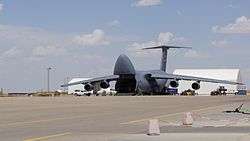


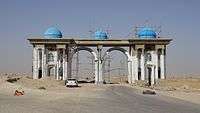
- Airports
- Mazar-i-Sharif Airport – serves the population of Balkh Province and is also used by NATO-led forces, including the Afghan Air Force. It is being expanded to become the 4th international airport in Afghanistan.
- Mosques
- Shrine of Ali
- Parks and monuments
- Maulana Jalaludin Cultural Park
- Tashkurgan Palace
- Governors Palace
- Mazar-i-Sharif Gate
- Khalid Ibn-al Walid Park[36]
- Universities
- Balkh University
- Aria University
- Sadat University
- Mawlana University
- Taj University
- Hospitals
- Regional Hospital of Mazar-i-Sharif
- Saleha Bayat Hospital
- Afghan National Army Regional Hospital at Camp Shaheen
- Hotels
- Serena Hotel Mazar-i-Sharif
- Aros-e-Shahr
- Mazar Hotel
- Farhat Hotel
- Kefayat hotel
- Barat Hotel
- Shinwari hotel
- Marco Polo hoteland hamsafar hotel
- Banks
- Social Organizations
- Balkh Youth Conformity Association
Sports
- Professional sports teams from Mazar-i-Sharif
| Club | League | Sport | Venue | Established |
|---|---|---|---|---|
| Balkh Legends | Afghanistan Premier League | Cricket | Sharjah Cricket Stadium | 2018 |
| Amo Sharks | Shpageeza Cricket League | Cricket | Balkh Cricket Stadium | 2013 |
| Simorgh Alborz F.C. | Afghan Premier League | Football | Ghazi Stadium | 2012 |
- Stadiums
- Balkh Cricket Stadium
- Buzkashi Stadium
Demography

The city of Mazar-i-Sharif has a total population of 693,000 (2015),[1] and is the third largest city of Afghanistan in terms of population.[1] It has a total land area of 8,304 Hectares with 77,615 total number of dwellings.[37]
Mazar-i-Sharif is a multiethnic and multilingual society of around 375,000 people. There is no official government report on the exact ethnic make-over but a map appeared in the November 2003 issue of the National Geographic magazine showing Tajiks 20%, Hazaras 55%, Pashtun 0.1%, Turkmen 8%, and Uzbeks 17%.[38] Occasional ethnic violence have been reported in the region in the last decades, mainly between Pashtuns and the other groups.[18][39][40][41] Some latest news reports mentioned assassinations taking place in the area but with no evidence as to who is behind it.[17]
The dominant language in Mazar-i-Sharif is Dari, an eastern variety of Persian, followed by Uzbeki and Pashto.
Economy and infrastructure
.jpg)
Mazar-i-Sharif serves as the major trading center in northern Afghanistan. The local economy is dominated by trade, agriculture and Karakul sheep farming. Small-scale oil and gas exploitation have also boosted the city's prospects. It is also the location of consulates of India and Pakistan for trading and political links.
Transportation
Rail

It became the first city in Afghanistan to connect itself by rail with a neighboring country. Rail service from Mazar-i-Sharif to Uzbekistan began in December 2011 and cargo on freight trains arrive at a station near Mazar-i-Sharif Airport,[42] where the goods are reloaded onto trucks or airplanes and sent to their last destinations across Afghanistan.
Air
As of June 2016 Mazar-i-Sharif Airport had direct air connections to Kabul, Mashad, Tehran, and Istanbul.
Road
Highway AH76 links Mazar-i-Sharif to Sheberghan in the west, and Pul-e Khomri and Kabul to the south-east. Roads to the east link it to Kunduz. Roads to the north link it to the Uzbek border town Termez, where it becomes highway M39 going north to Samarkand and Tashkent. Roads to the south link it to Bamiyan Province and the mountainous range of central Afghanistan.
Notable people
- Emir Wazir Akbar Khan, buried in the city
- Emir Sher Ali Khan, buried in the city
- Ajab Khan Afridi, freedom fighter against the British Raj
- Morsal Obeidi (German-Afghan murder victim) - Born in Mazar-i-Sharif,[43] moved to Germany at age three,[44] and lived in Mazar-i-Sharif for eight months after her parents sent her there to Islamize her.[45]
- Zalmay Khalilzad (Afghan born American diplomat)
See also
References
- "The State of Afghan Cities Report 2015". Archived from the original on 31 October 2015. Retrieved 21 October 2015.
- "On Tour in Afghanistan, Part 1: On the Highway from Kabul to Mazar-i-Sharif - Qantara.de". qantara.de. Retrieved 22 September 2018.
- "The State of Afghan Cities Report 2015". Archived from the original on 31 October 2015. Retrieved 21 October 2015.
- Boone, Jon (2 April 2011). "Afghanistan: when gentle Mazar-e-Sharif erupted in violence". the Guardian. Retrieved 22 September 2018.
- Schellinger, Paul; Salkin, Robert, eds. (1996). International Dictionary of Historic Places, Volume 5: Asia and Oceania. Chicago: Fitzroy Dearborn Publishers. pp. 578–579. ISBN 1-884964-04-4.
- host, just. "Welcome afghanmagazine.com - Justhost.com". www.afghanmagazine.com. Archived from the original on 1 June 2013. Retrieved 22 September 2018.
- Archived January 28, 2013, at the Wayback Machine
- The Last Warlord: The Life and Legend of Dostum, the Afghan Warrior Who Led US Special Forces to Topple the Taliban Regime by Brian Glyn Williams, 2013
- Qala, Chris Stephen in Dashti (20 October 2001). "Fighters to repay Taliban cruelty". the Guardian. Retrieved 22 September 2018.
- "Afghan powerbrokers: Who's who". BBC News. November 19, 2001. Retrieved 2011-04-01.
- Rashid,Taliban (2000), p.73.
- Goodson, Afghanistan's Endless War, (2001), p.79.
- THE MASSACRE IN MAZAR-I SHARIF, THE FIRST DAY OF THE TAKEOVER.
- Harding, Luke (2002-09-14). "Afghan Massacre Haunts Pentagon". The Guardian. London. Retrieved 2010-05-12.
- "As possible Afghan war-crimes evidence removed, U.S. silent". McClatchy Newspapers. 12-11-2008. Archived from the original on 2008-12-16. Check date values in:
|date=(help) - "US blocked probes into Afghan prisoner killings". AFP. 10-07-2009. Check date values in:
|date=(help) - Ehsas, Zabiullah (March 31, 2011). "Tribal elders in Balkh worry about assassinations". Afghanistan: Pajhwok Afghan News. Retrieved 2011-04-01.
- "Pashtuns say they're being brutalized". USA Today. United States. 05/12/2002. Retrieved 2011-04-01. Check date values in:
|date=(help) - "Balkh Monument". BBC Persian. 6 July 2006. Retrieved 2011-04-01.
- "AFP: Koran burnt in Florida church". google.com. Retrieved 22 September 2018.
- "UN staff killed during protest in northern Afghanistan". BBC News. April 1, 2011. Retrieved 2011-04-01.
- "10 UN workers killed, beheaded in Mazar attack". Pajhwok Afghan News. April 1, 2011. Retrieved 2011-04-01.
- Boone, Jon (April 1, 2011). "UN staff killed in Afghanistan amid protests over Qur'an burning". The Guardian. London. Retrieved 2011-04-01.
- "Pastor Terry Jones: 'We are not responsible'". BBC News. April 1, 2011. Retrieved 2011-04-01.
- "Obama condemns Quran burning 'bigotry'", Dawn, 3 April 2011 Archived April 8, 2011, at the Wayback Machine
- US Legislators Condemn Quran Burning, Violent Reaction Archived 2011-04-04 at WebCite, Voice of America, 3 April 2011
- Enayat Najafizada (July 23, 2011). "NATO hands control of Mazar-i-Sharif to Afghans". AFP. Retrieved July 23, 2011.
- "German consulate in Afghanistan". Fox News. Associated Press. Retrieved November 11, 2016.
- Fahim, Hamid. "Taliban attack German consulate in Afghanistan's Mazar-i-Sharif". yahoo.com. Agence France-Presse (AFP). Retrieved November 10, 2016.
- "Afghan casualties in Taliban Mazar-e Sharif attack pass 100". BBC News. 22 April 2017. Retrieved 23 April 2017.
- https://www.voanews.com/a/afghan-village-uses-live-rockets-to-build-homes-bridges-/4690545.html
- https://www.bbc.com/news/av/world-asia-47137978/the-afghan-village-built-from-missiles
- https://www.bbc.co.uk/programmes/p06ygr65
- "First snow of this winter covered North Afghanistan". Mazar-i-Sharif. Ariana News. 9 November 2011. Archived from the original on 2014-01-25. Retrieved 25 January 2014.
- "Mazar-i-Sharif Climate Normals 1959-1983". National Oceanic and Atmospheric Administration. Retrieved December 25, 2012.
- پارک تفریحی شهرک خالد ابن ولید |رسانه Archived 2014-02-02 at the Wayback Machine
- "The State of Afghan Cities Report 2015". Archived from the original on 31 October 2015. Retrieved 20 October 2015.
- "2003 National Geographic Population Map" (PDF). Thomas Gouttierre, Center For Afghanistan Studies, University of Nebraska at Omaha; Matthew S. Baker, Stratfor. National Geographic Society. November 2003. Retrieved 2012-07-21.
- Recknagel, Charles (March 14, 2002). "UN Condemns Attacks On Ethnic Pashtuns". hewad.com. Prague: Radio Free Europe/Radio Liberty. Retrieved 2011-04-01.
- "Pashtuns attacked in brutal raids by rival ethnic groups". Guardian News. buzzle.com. 2008. Archived from the original on 2005-02-09. Retrieved 2011-04-01.
- "Afghanistan: Situation in, or around, Aqcha (Jawzjan province) including predominant tribal/ethnic group and who is currently in control". Immigration and Refugee Board of Canada/UNHCR. February 1, 1999. Archived from the original on May 10, 2011. Retrieved 2011-04-01.
- "Afghan railway: First train runs on new line in north". BBC News. December 21, 2011.
- Hencke, Gerrit (2018-05-15). "Hamburg: Vor zehn Jahren starb Morsal Obeidi". Schleswig-Holsteinischer Zeitungsverlag (in German). Retrieved 2019-11-30.
Morsal Obeidi wurde am 7. September 1991 in Masar-e Scharif[...]
- Gutsch, Jochen-Martin; Per Hinrichs; Susanne Koelbl; Gunther Latsch; Sven Röbel; Andreas Ulrich (2008-05-27). "The High Price of Freedom". Der Spiegel. Translated by Christopher Sultan. p. 1. Retrieved 2019-11-30. - Original German version: "Eigentum des Mannes". - PDF page.
- Gutsch, Jochen-Martin; Per Hinrichs; Susanne Koelbl; Gunther Latsch; Sven Röbel; Andreas Ulrich (2008-05-27). "The High Price of Freedom". Der Spiegel. Translated by Christopher Sultan. p. 2. Retrieved 2019-11-30. - Original German version: "Eigentum des Mannes". - PDF page
Further reading
- 'The Massacre in Mazar-i Sharif'. Report of Human Rights Watch, November 1998, Vol. 10, No. 7 (C). Retrieved 18 November 2017.
- "Mazar-i-Sharif". The Encyclopædia Britannica (11th ed.). New York: Encyclopædia Britannica. 1910. OCLC 14782424.
- Noble Shrine or MAZAR-I-SHARIF a pilgrimage city in Afghanistan
- Dupree, Nancy Hatch (1977): An Historical Guide to Afghanistan. 1st Edition: 1970. 2nd Edition. Revised and Enlarged. Afghan Tourist Organization.
External links
| Wikimedia Commons has media related to Mazar-e-Sharif. |

- "Mezar-i Sharif". Islamic Cultural Heritage Database. Istanbul: Organisation of Islamic Cooperation, Research Centre for Islamic History, Art and Culture. Archived from the original on June 15, 2013.